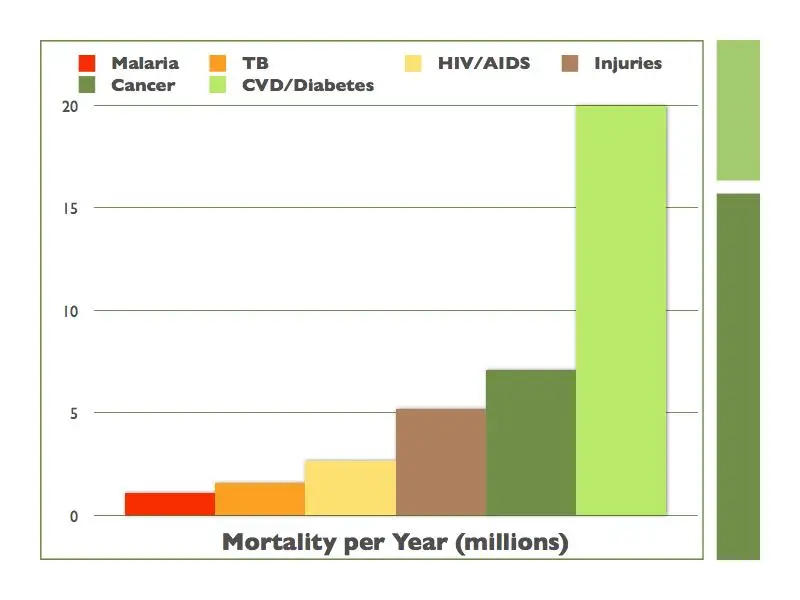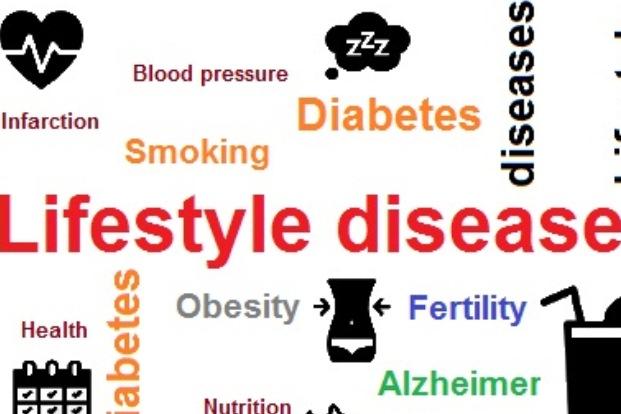In the fast-paced, technological world we live in, it’s easy to get caught up in the hustle and bustle of daily life without stopping to consider the impact our lifestyle choices have on our health. Lifestyle diseases, also known as non-communicable diseases, are a growing concern in society as we continue to prioritize convenience over well-being. Join us as we delve into the various examples of lifestyle diseases and explore the ways in which they can be prevented and managed.
Heading 1: Understanding Lifestyle Diseases and Their Impact on Health

Lifestyle diseases, also known as non-communicable diseases, are becoming increasingly prevalent in today’s society. These diseases are often a result of poor lifestyle choices such as unhealthy diet, lack of physical activity, and smoking.
<p>One common example of a lifestyle disease is Type 2 Diabetes. This chronic condition is often linked to obesity and a sedentary lifestyle. It can lead to serious complications such as heart disease, stroke, and kidney failure if not properly managed.</p>
<p>Another example is Hypertension, or high blood pressure. This condition can result from factors such as stress, poor diet, and lack of exercise. If left untreated, hypertension can increase the risk of heart disease, stroke, and kidney failure.</p>
<p>Other lifestyle diseases include obesity, cardiovascular disease, and certain types of cancer. These conditions can significantly impact one's quality of life and overall health. It is important to understand the causes and effects of these diseases in order to make positive changes to prevent them.</p>
Heading 2: The Role of Poor Diet in Contributing to Lifestyle Diseases

Lifestyle diseases are conditions that are primarily a result of the way a person lives their life. Poor diet plays a significant role in contributing to the development of these diseases. When individuals consistently consume unhealthy foods that are high in sugar, salt, and saturated fats, they are putting themselves at risk for various health problems.
Obesity is one of the most common lifestyle diseases that can be directly linked to a poor diet. Consuming too many calories and not getting enough nutrients can lead to weight gain, which in turn increases the risk of other serious health issues such as heart disease, diabetes, and stroke.
Furthermore, a diet high in processed foods and low in fruits and vegetables can lead to nutritional deficiencies that weaken the immune system and make the body more susceptible to illnesses. Inadequate intake of essential vitamins and minerals can also contribute to the development of conditions like anemia and osteoporosis.
| Health Problem | Contribution of Poor Diet |
| Heart Disease | High intake of saturated fats and cholesterol |
| Type 2 Diabetes | Excessive consumption of sugary beverages and processed foods |
| High Blood Pressure | Excessive salt intake |
It is crucial for individuals to be mindful of their dietary choices and strive to maintain a balanced and nutritious eating pattern. Making small changes, such as incorporating more fruits and vegetables into meals and reducing intake of processed and sugary foods, can have a significant impact on overall health and well-being.
Heading 3: Sedentary Lifestyle: A Major Risk Factor for Developing Chronic Conditions

Living a sedentary lifestyle can significantly increase the risk of developing chronic conditions. Conditions such as obesity, heart disease, diabetes, and high blood pressure are all linked to a lack of physical activity and prolonged periods of sitting.
**Health Risks of a Sedentary Lifestyle**
- Increased risk of weight gain
- Higher chances of developing heart disease
- Elevated blood pressure levels
- Greater likelihood of developing Type 2 diabetes
**Impact on Mental Health**
Furthermore, a sedentary lifestyle can also have negative effects on mental health, leading to increased feelings of anxiety, depression, and stress.
**Preventive Measures**
- Engage in regular physical activity, such as brisk walking or running
- Incorporate strength training exercises into your routine
- Take frequent breaks from sitting, even if it’s just to stretch or walk around
- Work towards achieving at least 150 minutes of moderate-intensity exercise per week
Heading 4: Stress and Its Connection to Lifestyle Diseases

Modern society is constantly bombarding individuals with stress from various sources, such as work, relationships, financial pressures, and societal expectations. This chronic stress can have a significant impact on our health, leading to the development of lifestyle diseases. These diseases are often linked to our daily habits and choices, making them preventable through lifestyle modifications.
One example of a lifestyle disease that is closely connected to stress is hypertension, or high blood pressure. When we experience stress, our bodies release adrenaline and cortisol, which can cause our blood pressure to rise. If this happens frequently over a prolonged period of time, it can lead to hypertension, increasing the risk of heart disease, stroke, and other serious health issues.
Another common lifestyle disease that is influenced by stress is diabetes. Stress can affect blood sugar levels, as the body releases glucose as a response to stress hormones. Over time, this can contribute to insulin resistance and diabetes. Managing stress through relaxation techniques, exercise, and a healthy diet can help prevent the development of this disease.
In addition to hypertension and diabetes, stress is also linked to obesity, which is a leading risk factor for many lifestyle diseases, including cardiovascular disease, certain types of cancer, and metabolic disorders. Stress can lead to emotional eating, poor food choices, and a sedentary lifestyle, all of which can contribute to weight gain and obesity. Finding healthy ways to cope with stress, such as exercise, mindfulness, and social support, is essential in preventing obesity and its associated health risks.
Heading 5: Sleep Deprivation: A Silent Contributor to Poor Health

Sleep deprivation is a commonly overlooked issue that can have serious consequences on our overall health. While it may seem harmless to sacrifice a few hours of sleep here and there, the truth is that chronic lack of sleep can lead to a multitude of health problems.
One of the most concerning effects of sleep deprivation is its impact on mental health. Lack of sleep can lead to irritability, mood swings, and difficulty concentrating. In the long term, it can even contribute to the development of anxiety and depression.
Furthermore, inadequate sleep has been linked to an increased risk of obesity. When we don’t get enough rest, our bodies produce more of the hunger hormone ghrelin and less of the hormone leptin, which signals feelings of fullness. This can lead to overeating and weight gain.
On top of mental and physical health issues, sleep deprivation can also weaken our immune system, making us more susceptible to illnesses such as colds and flu. Inadequate sleep can also contribute to high blood pressure, heart disease, and diabetes.
It’s clear that getting enough sleep is crucial for maintaining good health. Making sleep a priority in our daily routines can help prevent a host of lifestyle diseases and improve our overall well-being.
Heading 6: Strategies for Preventing Lifestyle Diseases Through Healthy Habits

Lifestyle diseases are conditions that are primarily caused by unhealthy habits and choices that individuals make in their daily lives. These diseases are preventable and can be managed through adopting healthy habits and making positive lifestyle changes. By incorporating these strategies into your daily routine, you can reduce the risk of developing lifestyle diseases and improve your overall health and well-being.
One key strategy for preventing lifestyle diseases is to maintain a balanced and nutritious diet. Eating a variety of fruits, vegetables, whole grains, and lean proteins can provide your body with the essential nutrients it needs to function properly. Avoiding processed foods, sugary drinks, and excessive amounts of salt and saturated fats can help reduce the risk of developing conditions such as obesity, diabetes, and heart disease.
Regular physical activity is another important aspect of preventing lifestyle diseases. Engaging in activities such as walking, jogging, swimming, or cycling can help improve cardiovascular health, strengthen muscles, and maintain a healthy weight. Aim for at least 150 minutes of moderate-intensity exercise each week to see optimal health benefits.
Getting an adequate amount of sleep each night is essential for overall health and well-being. Lack of sleep has been linked to an increased risk of developing conditions such as obesity, diabetes, and high blood pressure. Aim for 7-9 hours of quality sleep each night to help your body recharge and repair itself.
| Meal | Food |
|---|---|
| Breakfast | Whole grain toast with avocado and eggs |
| Lunch | Grilled chicken salad with mixed greens and vinaigrette |
| Dinner | Baked salmon with quinoa and steamed broccoli |
Heading 7: The Importance of Regular Exercise in Maintaining Overall Well-being

Regular exercise plays a crucial role in preventing a variety of lifestyle diseases that can impact overall well-being. By incorporating physical activity into our daily routines, we can lower the risk of developing conditions such as obesity, diabetes, heart disease, and high blood pressure.
Exercise helps maintain a healthy weight by burning calories and boosting metabolism. Additionally, it strengthens the heart and improves circulation, reducing the likelihood of heart-related illnesses. Furthermore, regular physical activity has been linked to lower blood pressure levels, keeping the cardiovascular system in optimal condition.
In addition to its physical benefits, exercise also has a positive effect on mental health. Engaging in physical activity releases endorphins, which are known to improve mood and reduce stress. Exercise can also enhance cognitive function and promote better sleep, leading to an overall sense of well-being.
Incorporating a mix of cardiovascular, strength training, and flexibility exercises into your routine is key to reaping the full benefits of physical activity. Remember, consistency is key when it comes to maintaining overall well-being through regular exercise. So lace up those sneakers, hit the gym, or take a walk outside – your body will thank you for it!
Heading 8: Seeking Professional Help for Managing and Treating Lifestyle Diseases

Lifestyle diseases, also known as non-communicable diseases (NCDs), are health conditions that are primarily caused by unhealthy lifestyle choices such as poor diet, lack of physical activity, smoking, and excessive alcohol consumption. These diseases can have a significant impact on an individual’s quality of life and overall well-being. Seeking professional help for managing and treating lifestyle diseases is crucial for effectively addressing the underlying causes and preventing further complications.
When it comes to managing lifestyle diseases, medical professionals such as doctors, nutritionists, and physical therapists play a crucial role in providing personalized treatment plans and guidance. By consulting with these professionals, individuals can receive expert advice on making necessary lifestyle changes, implementing healthy habits, and monitoring their progress towards better health.
Professional help can also involve the use of medications or medical interventions to help manage symptoms and prevent complications associated with lifestyle diseases. For example, individuals with diabetes may require insulin therapy or oral medications to control their blood sugar levels, while those with high blood pressure may need to take medication to lower their blood pressure.
Additionally, professional help for managing lifestyle diseases may include regular check-ups, screenings, and monitoring of key health indicators to track progress and make necessary adjustments to treatment plans. By working closely with healthcare providers, individuals can take proactive steps towards improving their health and reducing their risk of developing further health complications.
Q&A
Q: What are lifestyle diseases and why are they becoming more prevalent in society?
A: Lifestyle diseases are health conditions that are primarily caused by the way people lead their lives, including factors such as diet, physical activity, and stress. These diseases are becoming more common in society due to the rise of sedentary lifestyles, poor dietary choices, and increasing stress levels.
Q: Can you provide some examples of lifestyle diseases?
A: Some common examples of lifestyle diseases include heart disease, type 2 diabetes, obesity, hypertension, and certain types of cancer. These conditions are often preventable and can be managed through lifestyle changes such as improving diet, increasing physical activity, and reducing stress.
Q: How do lifestyle diseases impact individuals and communities?
A: Lifestyle diseases can have a significant impact on individuals in terms of their quality of life, ability to work, and overall well-being. In communities, these diseases can place a strain on healthcare systems, increase healthcare costs, and contribute to lower productivity levels.
Q: What steps can individuals take to prevent lifestyle diseases?
A: To prevent lifestyle diseases, individuals can take steps such as maintaining a healthy diet rich in fruits and vegetables, engaging in regular physical activity, managing stress levels, avoiding tobacco and excessive alcohol consumption, and getting regular check-ups with healthcare providers.
Q: Are there any resources available to help individuals manage lifestyle diseases?
A: Yes, there are resources available to help individuals manage lifestyle diseases such as support groups, wellness programs, educational materials, and online resources. Healthcare providers can also provide guidance on how to prevent and manage these conditions effectively.
Final Thoughts
In conclusion, lifestyle diseases are a growing concern in today’s society, with factors such as diet, exercise, and stress playing a significant role in their development. By making small changes to our daily habits and prioritizing our health and well-being, we can reduce our risk of developing these preventable conditions. Remember, it’s never too late to start taking control of your health and living a healthier lifestyle. Let’s strive to make positive choices that will benefit our bodies and minds for years to come.



